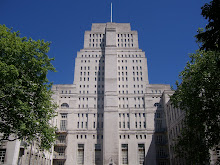In 1930 Frank Pick, the managing director of London Transport, took his architect Charles Holden on a tour round Europe to find inspiration for new tube lines that would inch into rural Middlesex. You can see signs of what they found everywhere on the Piccadilly Line stations they built in the early 1930s. So on this tube journey we will find brickwork borrowed from the Hilversum of Wilhelm Marinus Dudok, the weird expressionist ceilings of Manor House, the rectilinear watchtower of Turnpike Lane, the bauhaus unsupported glass corners of Bounds Green, the cinema-style kiosk architecture of Wood Green, the serene, severe Swedish classicism of Arnos Grove, the Metropolis fantasia of Southgate, with its curving shopping parade, topped with a futuristic beacon. Finally, we come to the concrete concourse of Cockfosters, which seems to usher you into Mitteleuropa rather than the commuter belt.
The Piccadilly Line extension is what interwar London had in lieu of an avant-garde, a total artwork made up of architecture and signage by Charles Holden, posters by E McKnight Kauffer or Moholy-Nagy, to sit on tube seats designed by Marion Dorn and Paul Nash. Modernism was not allowed into the heritage city, so it set up its illuminated outposts in the outer suburbs, in a doomed attempt at changing the centre from the periphery. So while on this journey we will try to imagine these tube stations stretched up to 20 storeys – their expanses of glass, their crepuscular London light, the signscape of their posters, light fittings, roundels, decorated tiles and friezes – into a glorious modernist skyscraper which would be everything the stone severity of Senate House is not. Meeting at Russell Square Station, 2pm, Sunday October 4 2009.


No comments:
Post a Comment